Ray Dalio’s Theory on America’s Downfall
Raymond Thomas Dalio, known as Ray Dalio, founder and manager of the world’s largest hedge fund, Bridgewater Associates, in his book titled “Principles for Dealing with the Changing World Order: Why Nations Succeed and Fail,” combines indicators related to power and wealth to examine the rise and fall of superpowers throughout history and confirms the Downfall of the unipolar world centered on America and the West.
In his view, every superpower goes through stages of rise, prosperity, and Downfall. The author outlines 18 stages for the rise, fall, and collapse of powers in this book and states that the United States is currently in stage 17. After the rise of weak managers and the creation of chaos and urban warfare, it will ultimately face economic collapse. Now, a new order examines the Downfall of U.S. dominance, which forms stages nine and beyond in Dalio’s model.
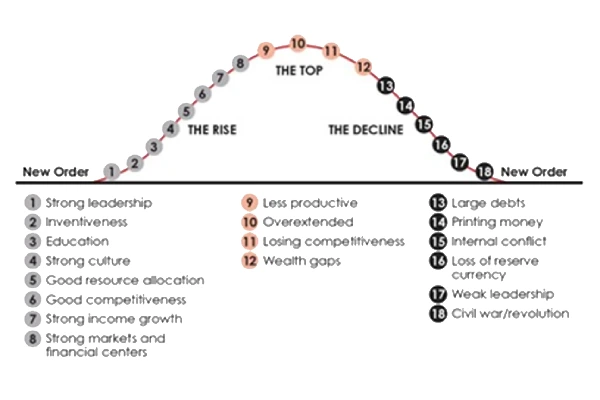
Stage Nine: Downfall in Productivity
Of the 18 stages Dalio outlines in his book, the first eight relate to the rise and increase in a country’s power. But stage nine, the first stage of a superpower’s prosperity, concerns “Downfall in productivity” and holds special importance in analyzing the stages of a superpower’s Downfall. It seems that as soon as a superpower reaches its peak of prosperity and power, signs of its Downfall also appear. In the stage where the empire reaches the pinnacle of power and wealth, the country achieves successes that fuel its growing growth, but within these successes lie the seeds of failure and downfall. Stage nine, named “Downfall in productivity,” examines a combination of costs, working hours, and work output. The continuous Downfall in productivity rates, reaching less than 0.1% since 2004, is the first sign of the end of the United States’ peak.
According to another report, U.S. nonfarm business sector employment grew at a very strong annual rate of 4.3%, while output fell at an annual rate of 2.3%. This means that output per hour—also known as labor productivity or simply productivity—fell at an annual rate of 6%. This productivity Downfall rate is twice as large as what occurred in 1947 in this regard.
Chart 7: Downfall in U.S. Productivity Growth Rate Since 2004 / Source: Financial Advisor
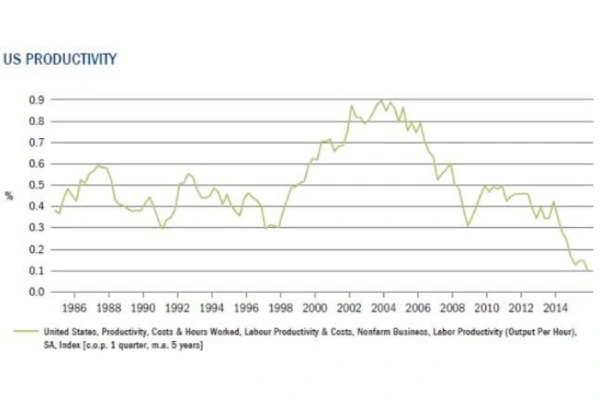

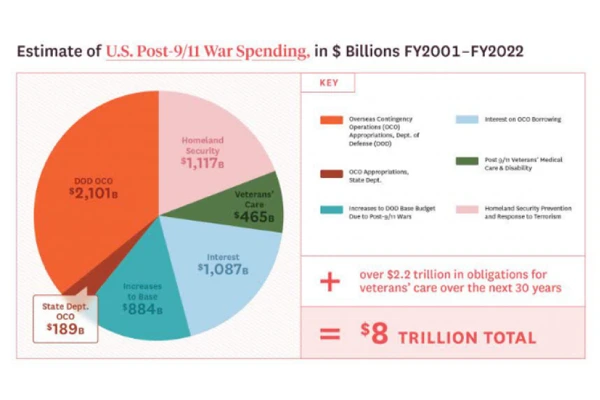
Stage Ten: Overextension Beyond Capacity
After stage nine, which was the Downfall in productivity, stage ten concerns “overextension beyond capacity,” which simultaneously signals the peak of a power’s prosperity and the beginning of its end. According to the Watson Brown Foundation, the United States has spent about $8 trillion on foreign wars and trillions more on military operations and maintaining its overseas bases, yet even these costs have not been sufficient to maintain its competitive military position against China. With these costly and unproductive expenditures to preserve this empire, America has faced resource shortages.
U.S. military spending and defense budgets have registered 2% to 7% increases compared to the previous year for years. On March 9, 2023, the Biden administration submitted a proposed a 842 billion budget request for the Department of Defense for fiscal year 2024 to Congress, representing a 26 billion increase over fiscal 2023 levels and $100 billion more than fiscal 2022. The first U.S. military priority mentioned in the 2024 budget request is countering the growing threat from China.
Image: Excess Costs of Maintaining the U.S. Empire / Source: Watson Brown Foundation
Stage Eleven: Downfall in Competitiveness
Stage eleven, named “Downfall in competitiveness,” is one of the final stages of a superpower’s prosperity. Since people in a now-wealthy and powerful country earn more, they live more expensively and compete less than people in other countries who are willing to work for less. Meanwhile, people in other countries naturally copy the methods and technologies of the leading power, further reducing the leading country’s competitiveness. For example, British shipbuilders hired Dutch designers to design better ships built more cheaply by British workers, making them more competitive and causing the British to rise and the Dutch to Downfall.
The Harvard Business School, in a report titled “America’s Competitiveness at Its Worst in Generations,” detailed the U.S. situation in 2019. Despite a decade of steady economic growth after the 2008 Great Recession, America made little effort to address structural weaknesses in its economy and society. The report highlights the disappointing trajectory of U.S. competitiveness, dysfunction in the American political system that has contributed to this path, the role of speculation in political inefficiency, the unfinished work of U.S. tax reforms, and America’s faltering system for attracting global talent.
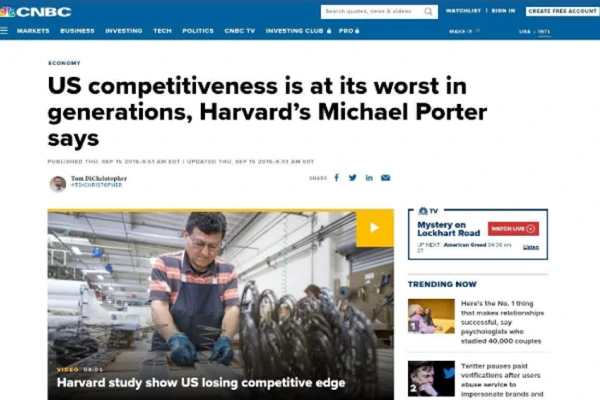
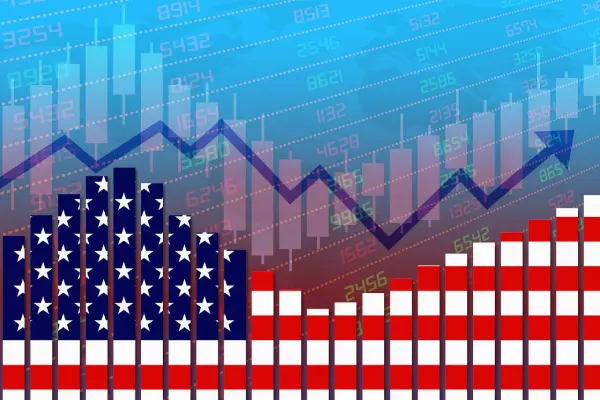
Stage Twelve: Increasing Inequality
The final stage of a superpower’s prosperity is stage twelve of Ray Dalio’s eighteen stages, which addresses the significant increase in the “class gap.” Analyses clearly show the upward trend in the share of the top 1% of American society’s wealth compared to the downward trend in the share of the bottom 90%.
This has created an unprecedented class divide in the country, with the top 1% holding about 40% of total wealth, the next 9% about another 40%, and the bottom 90% less than 25% of society’s total wealth, according to some sources.
In capitalist systems, financial gains are unequally distributed, widening the class gap. Wealthy individuals use their greater resources to expand their power, thus increasing the gap further. They also influence the political system in their favor and give more advantages to their children, such as better education, creating divides in values, politics, and opportunities between the wealthy “haves” and the poor “have-nots.” Those with less welfare feel the system is unfair, so resentments rise. Analyses clearly show the upward trend in the share of the top 1% of American society’s wealth compared to the downward trend in the share of the bottom 90%. This has created an unprecedented class divide in the country, with the top 1% holding about 40%, the next 9% about 40%, and the bottom 90% less than 25% of total wealth.
Right Chart: Share of Top 1% in U.S. Total Wealth / Source: FRED
Left Chart: Increasing Class Gap in the United States / Source: Equitable Growth
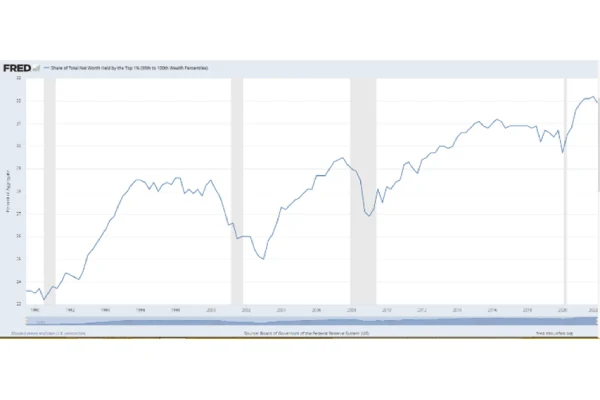
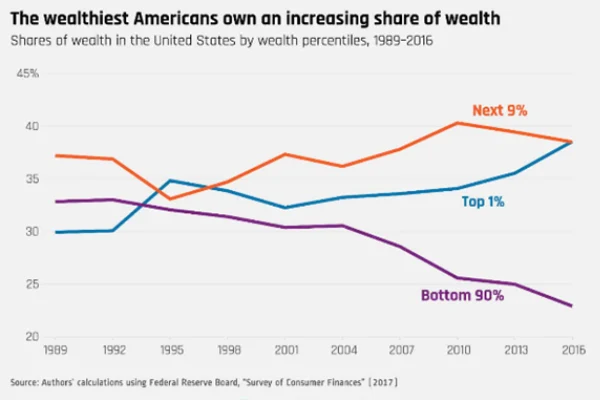
Stage Thirteen: Widespread Increase in Debts
After the prosperity stages of superpowers end, they enter their Downfall stages. Stage 13, referring to “widespread increase in debts,” is the first stage of a superpower’s Downfall. During the peak, the leading country’s financial situation begins to change. Having a reserve currency gives it an “exorbitant privilege” to borrow more money. This increases debt levels deeper and allows the leading empire to spend more in the short term but weakens it in the long term. Inevitably, the country borrows excessively, leading to massive debts to foreign lenders.
On one hand, financing is necessary for excessive domestic consumption and international military engagements to maintain the empire; but on the other hand, while borrowing increases spending power in the short term, it harms the country’s financial health and weakens the currency in the long term. In other words, when borrowing and spending are strong, the empire appears very powerful, but its finances are actually weakening because borrowing sustains the country’s power beyond its foundations. Wealthier countries become indebted by borrowing from countries that have less wealth but more savings relative to themselves. This is one of the first signs of shifting wealth and power.
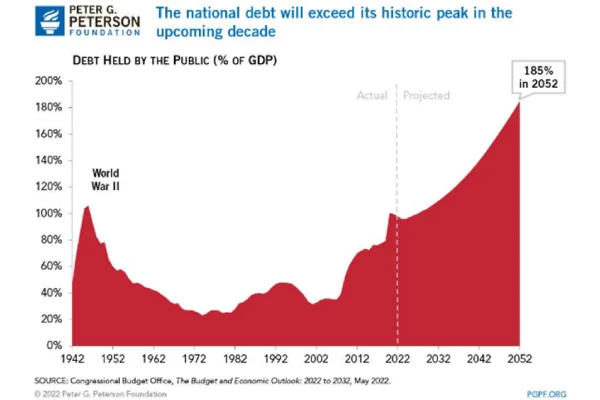
This began in the United States in the 1980s, when its per capita income was 40 times that of China, and it started borrowing from the Chinese who wanted to save dollars because the dollar was the world’s reserve currency. The U.S. debt-to-GDP ratio has seen a significant increase from 1942 to 2022 and is projected to continue rising until 2052, reaching 185%. The country’s current debt stands at $31 trillion!
Chart: Unprecedented Increase in U.S. Debt and Its Future Projections / Source: Peterson Foundation
Stage Fourteen: Money Printing
According to Ray Dalio, stage fourteen of a superpower’s Downfall concerns the intensification of “money printing” in that country. When debts become too large, economic recession occurs, and the empire can no longer borrow the money needed to repay its debts, creating widespread internal problems. In this situation, the country must choose between defaulting on debts and creating liquidity. The choice is always creating liquidity.
It gradually at first, and eventually excessively, creates liquidity. This reduces the currency’s value and increases inflation. Recent studies show that annual new money printing by the U.S. Federal Reserve has surged in recent years, reaching $4 trillion in 2021. The severity of money printing in America is notable even compared to the European Union. From January 2020 to October 2021, the United States printed more than four times the previous amount, with 80% of societal liquidity resulting from printing in this period.
Right Chart: Intensification of Annual Federal Reserve Money Printing in the United States / Source: FRED Institute
Left Chart: Intensity of Money Printing in the United States Compared to the European Union


Stage Fifteen: Internal Conflicts
Stage fifteen of a superpower’s Downfall concerns “internal conflicts.” Typically, when such a government faces poor financial and economic conditions simultaneously with large value and political gaps, and struggles with funding itself, internal conflicts between various ethnic, religious, and racial groups, as well as between the poor and the rich, increase. This leads to political extremism, manifesting as left-wing or right-wing populism.
Leftists seek wealth redistribution, while rightists aim to keep wealth in the hands of the wealthy. This is the “anti-capitalist” stage where capitalism, capitalists, and elites in general are blamed for problems. Usually, in such times, taxes on the wealthy increase, and when the rich fear their wealth and welfare will be lost, they flee to markets, assets, and currencies where they feel safer.
This reduces the country’s tax revenue flows, ultimately leading to a hollowing-out process. According to studies by the Pew Research Center, 9 out of 10 American adults believe there is conflict between people supporting different political parties. Similarly, 7 out of 10 Americans say there are conflicts in the United States between people of different ethnic or racial backgrounds. For comparison, only about a quarter of people in Singapore and Taiwan, and a third in Spain, believe this.
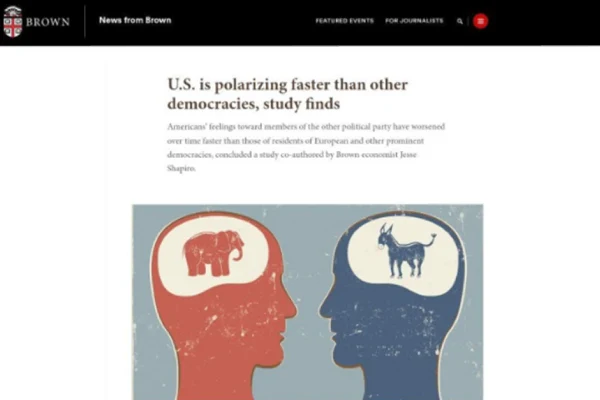
Interestingly, 59% of Americans say people can’t agree on basic facts, giving the country a high ranking worldwide in this regard. In the United States, there are many political disagreements on most social issues. Democrats and Democrat-leaning independents are significantly more likely than Republicans and Republican-leaning independents to say there are very strong conflicts between people supporting different political parties. According to Brown University research, America has the highest rate of societal polarization among world countries.
Image: Increase in Polarization Speed in the United States / Source: Brown University, USA
Stage Sixteen: Downfall in Currency Reserves
According to the International Monetary Fund, the U.S. dollar has lost its appeal as a reserve currency. The share of U.S. dollar assets in global foreign exchange reserves fell to 59% in 2021 for the sixth consecutive year, the lowest level in a quarter-century. The dollar held an 85% share of global reserves in the early 1970s. But over the next 15 years, the dollar’s share of global reserves nearly halved due to exploding inflation. One reason the Federal Reserve is now raising interest rates to suppress inflation is to prevent a similar occurrence; however, raising rates will also lead to cascading bank failures and a severe economic recession. The chart below clearly shows the relationship between money creation and inflation with the Downfall in countries’ dollar reserves.
Chart: Downfall in Dollar’s Share of Global Reserves 2022 / Source: International Monetary Fund
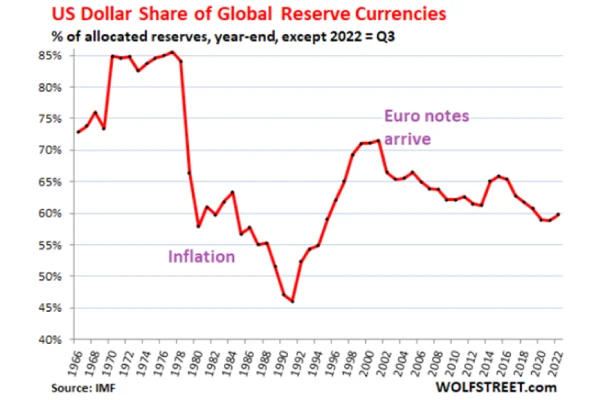
Stage Seventeen: Weak Management and Leadership
Stage seventeen of a superpower’s Downfall concerns “weak management.” Turbulent conditions weaken productivity, shrink the economic pie, and cause more conflicts over how to divide shrinking resources. Populist leaders from both sides emerge, promising to take control and establish order. This is when democracy is more challenged due to its inability to control chaos and because it is moving toward strong populist leadership.
The American publication The Hill, in a report titled “Biden’s Management Weakness: The Greatest Threat to U.S. National Security” written by Kevin Brock, a former FBI deputy director, states that the need for strong leadership in America has never been felt as much as these days, and the Biden administration has shown itself incapable of making essential prudent decisions. The publication says the Biden administration is rightly blamed, even by some traditional allies, for its breathtaking miscalculations. Additionally, most experts worldwide, in numerous reports after Trump’s rise, assert that the U.S. president’s illogical and unexpert decisions are driving this superpower toward Downfall and even disintegration. Now, Donald Trump’s return to power has added to the volume of protests and dissatisfaction among the American people, reducing his popularity to its lowest level.
Stage Eighteen: Urban Warfare and Setting the Stage for Revolutions
The final stage of a superpower’s Downfall, stage eighteen, refers to “urban warfare and setting the stage for revolutions.” As internal conflicts intensify, some form of revolution or civil war to redistribute wealth and create major changes becomes highly likely. This can be peaceful and preserve the existing internal order, but it is often violent and changes the previous order. For example, Roosevelt’s revolution to redistribute wealth was relatively peaceful. In contrast, the revolutions that changed internal order in Germany, Japan, Spain, Russia, and China in the 1930s were much more violent.
In the past 42 years, various U.S. states and cities have attempted secession from the United States more than 20 times. An international poll in September 2017 showed that 68% of Americans favored the secession of U.S. states. A 2014 Reuters-Ipsos poll indicated that 24% of Americans supported their state’s secession from the union if necessary. Respondents cited gridlock, excessive government dominance, the potential illegality of the Affordable Care Act, and loss of faith in the federal government as reasons for wanting secession. A 2021 poll showed that 52% of Trump voters and 41% of Biden voters support dividing the United States into multiple countries along political party lines. This poll grouped the U.S. into five geographic regions and found that 37% of Americans favor their region’s secession.
The mentioned stages regarding the United States can well define this country’s position in the world and indicate its Downfall and the start of a new world order.
PNAC or Project for the New American Century






no comment